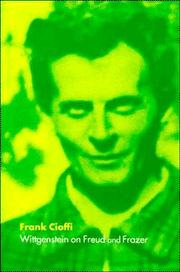Book contents
- Frontmatter
- Contents
- Acknowledgements
- Introduction: Wittgenstein on explanation and self-clarification
- 1 Information, contemplation and social life
- 2 Aesthetic explanation and aesthetic perplexity
- 3 Wittgenstein and the Fire-festivals
- 4 When do empirical methods by-pass ‘the problems which trouble us’?
- 5 Explanation, self-clarification and solace
- 6 Wittgenstein on making homeopathic magic clear
- 7 Wittgenstein and obscurantism
- 8 Wittgenstein on Freud's ‘abominable mess’
- 9 Congenital transcendentalism and ‘the loneliness which is the truth about things’
- AFTERWORD
- Index
4 - When do empirical methods by-pass ‘the problems which trouble us’?
Published online by Cambridge University Press: 05 January 2010
- Frontmatter
- Contents
- Acknowledgements
- Introduction: Wittgenstein on explanation and self-clarification
- 1 Information, contemplation and social life
- 2 Aesthetic explanation and aesthetic perplexity
- 3 Wittgenstein and the Fire-festivals
- 4 When do empirical methods by-pass ‘the problems which trouble us’?
- 5 Explanation, self-clarification and solace
- 6 Wittgenstein on making homeopathic magic clear
- 7 Wittgenstein and obscurantism
- 8 Wittgenstein on Freud's ‘abominable mess’
- 9 Congenital transcendentalism and ‘the loneliness which is the truth about things’
- AFTERWORD
- Index
Summary
His discussion of aesthetics was mingled in a curious way with criticism of assumptions which he said were made by Frazer in The Golden Bough and also with criticisms of Freud.
(G. E. Moore, ‘Wittgenstein's Lectures, 1930–3’)Every explanation is an hypothesis … But for someone worried by love, an explanatory hypothesis will not help much. I will not bring peace … The crush of thoughts that do not get out because they all press forward and are wedged in the door.
(‘Remarks on Frazer's Golden Bough’)For us, the concept of a perspicuous presentation is fundamental … This perspicuous presentation makes possible that understanding which consists in seeing the connections.
(‘Remarks on Frazer's Golden Bough’)An entirely new account of correct explanation. Not one agreeing with experience, but one accepted. You have to give the explanation which is accepted. This is the whole point of the explanation.
(Lectures and Conversations in Aesthetics)Wittgenstein thinks it was wrong of Frazer to respond to the Fire-festivals by launching an investigation into their origins, and of Freud to respond to dreams by looking for causal relations between them and other aspects of our lives. What kind of mistake is this? Is it the same mistake? Is it really a mistake?
Wittgenstein's criticisms of Freud and Frazer have an interest which extends beyond Wittgensteinian exegesis because they raise a much broader problem, which one might formulate as follows:
There are questions which present themselves as empirical, i.e. such that they require further information for their resolution, but with respect to which we are told, or come to feel obscurely ourselves, that this is an illusion, that the consummation we are seeking is not to be found in more empirical knowledge, or via scientific explanation, but elsewhere and otherwise.
Information
- Type
- Chapter
- Information
- Wittgenstein on Freud and Frazer , pp. 107 - 127Publisher: Cambridge University PressPrint publication year: 1998
